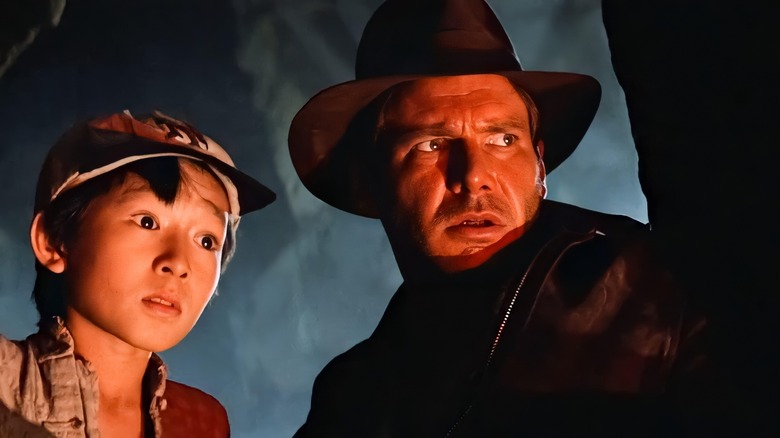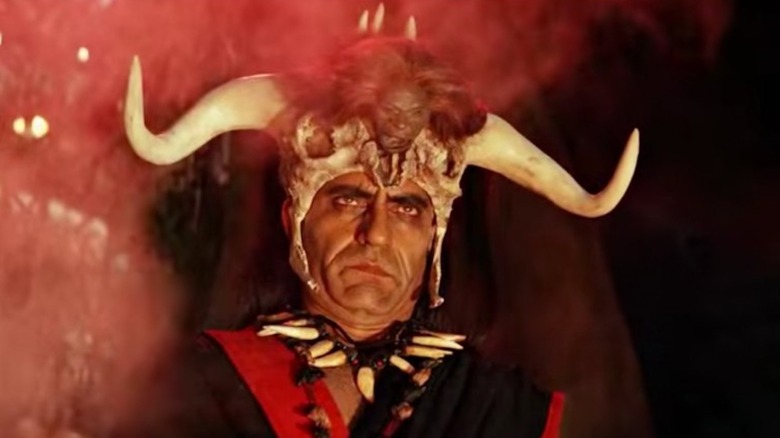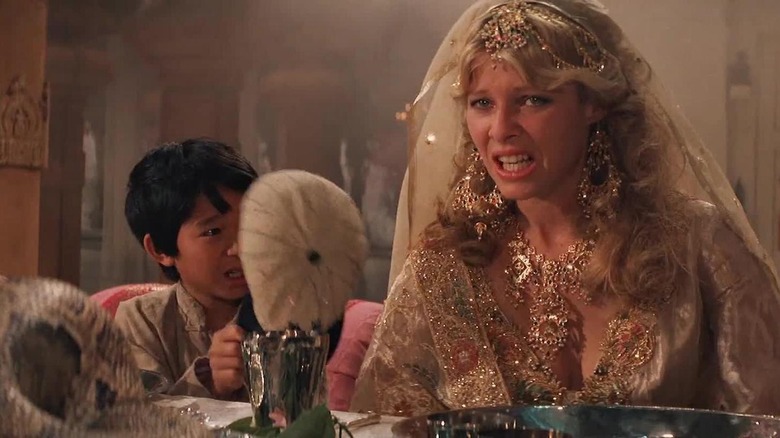Indiana Jones And The Temple Of Doom Was Banned In India – For Obvious Reasons
Steven Spielberg was two years removed from a watershed 1982 that firmly established him as Hollywood's preeminent blockbuster auteur when he gleefully trashed that reputation with "Indiana Jones and the Temple of Doom."
Spielberg's reputation as a Pollyannaish dream merchant required selective readings of his first seven theatrical features (and, yes, we're including "Duel," which received a small release after scoring huge ratings on NBC). His successes were crowd-pleasing thrill rides that sent people walking out of the theater on air, but you didn't have to dig too deep to see the darkness lurking under their big-budget surfaces. "Close Encounters of the Third Kind" concludes with Richard Dreyfuss leaving his bummer family to explore the cosmos. "Raiders of the Lost Ark" is a rollicking adventure that ends in failure. "E.T. the Extra-Terrestrial" is a deeply sad movie that's essentially "The Wizard of Oz" in reverse.
But a rep is a rep, and Spielberg was America's go-to popular storyteller. At least he was until "Indiana Jones and the Temple of Doom." Though I think it's one of the most entertaining movies ever made, a non-stop adventure that gets shockingly dark because it knows it's going to lift you up in the end, the violence was so excessive for a PG-rated movie that, along with the equally gory "Gremlins," it compelled the MPAA to create the PG-13.
Critics attacked Spielberg for betraying the trust of the American public with a gross-out spectacle, but they were largely mum on the film's most objectionable element. India, however, was all over it, to the extent that they forbade its release.
A Hollywood blockbuster inspired by British colonialism
It is impossible to watch "Indiana Jones and the Temple of Doom" today and not be stunned by its fear-mongering depiction of Indian people, though if you're aware of the two films that inspired it, you at least know how Spielberg got here.
The screenplay by Willard Huyck and Gloria Katz ("Raiders of the Lost Ark" writer Lawrence Kasdan wanted no part of this movie) hurtles the adventuring archaeologist into an Indian village robbed of its children. They've been kidnapped and forced into hard labor by a Thuggee cult that's seized power in a nearby palace. The Thuggee project elegance and hospitality, but we soon learn that they're carrying out gruesome ritualized sacrifices in the bowels of the sprawling estate. They're literally rip-your-beating-heart-out-of-your-chest bad guys.
Spielberg is clearly riffing on Howard Hawks' 1939 classic "Gunga Din," wherein three British soldiers are taught a lesson in bravery from their water-carrying Indian companion. In that film, the Thuggee are oppressive villains who must be eradicated by the civilizing force of the British army — and when Cary Grant, the greatest movie star of all time, is on the side of the British, your rooting interest is guaranteed.
But Spielberg is also drawing from Terence Fisher's "The Stranglers of Bombay," a Hammer-produced horror-adventure that depicts the Thuggee in all their (alleged) vicious glory. There is torture, dismemberment, and an epilogue featuring a quote from the very real Major General William Sleeman, who justifies the British empire's colonial conquest by saying "If we have nothing else for India, we have done this one good thing."
"Indiana Jones and the Temple of Doom" might possess the exuberance of "Gunga Din," but it's imbued with the nastiness of "The Stranglers of Bombay." And this, unsurprisingly, did not play well in India.
No time for chilled monkey brains, Dr. Jones
The existence of the Thuggee cult in Indian history is not up for debate (though modern historians believe the British might've overplayed their evilness). But Spielberg, Huyck and Katz were paying homage to movies they loved in their youth, which leaned heavily on the counterfactual exoticness of foreign cultures. Their debt to historical accuracy was non-existent.
The Thuggees' brutal ceremonies are pulp nonsense that you can (generously) attribute to occultist cliche; these sequences would be right at home in a witch-hunting exploitation flick like Michael Armstrong's "Mark of the Devil." The dinner sequence at the palace, however, is incredibly ill-judged. If Chattar Lai (Roshan Seth), the seemingly refined prime minister, wants to throw Indy and his companions off the scent, why would he subject them to an extravagant, multi-course meal consisting of live bugs, eyeball soup, and chilled monkey brains? And, uh, where in the world, outside of "Faces of Death," is this kind of debauched cuisine served?
This kind of outlandish othering rightfully cheesed off the Indian government, and that's why they banned "Indiana Jones and the Temple of Doom," the most entertaining movie ever made that couldn't be made today — and for good reason.


